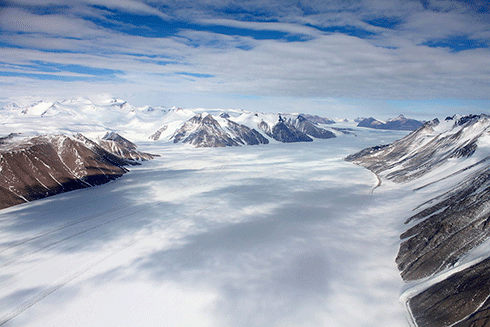
|
Published: 18 November 2013
‘No-slip strips’ slow the flow of Antarctic glaciers
Narrow stripes of dirt and rock beneath massive Antarctic glaciers create friction zones that slow the flow of ice toward the sea, according to a recent paper published in Science by researchers at Princeton University and the British Antarctic Survey (BAS).

|
|
Antarctica’s glaciers are massive, moving ice sheets, with thicknesses measured in kilometres, that can contribute substantially to sea-level rise when they flow into the ocean. Credit:
Eli Duke
|
Understanding how these high-friction regions form and subside could help researchers understand how the flow of these glaciers responds to a warming climate.
Just as no-slip strips on flooring prevent people from slipping on a wet floor, these ribs or ‘tiger stripes’ – named in reference to Princeton's tiger mascot – provide friction that hinders the glaciers from slipping along the underlying bed of rock and sediment, according to the paper.
The researchers discovered the slightly curved ribs – which occur in large, slippery regions under the glaciers – using mathematical modelling based on data from the National Snow and Ice Data Center and the British Antarctic Survey. The work was conducted by Princeton’s Olga Sergienko and BAS’s Richard Hindmarsh.
Antarctica’s glaciers are massive, moving ice sheets, with thicknesses measured in kilometres, that can contribute substantially to sea-level rise when they flow into the ocean.
The researchers studied two glaciers, the Pine Island Glacier and the Thwaites Glacier in West Antarctica, which together have contributed about 10 per cent of the observed sea-level rise over the past 20 years, despite their small areas.
Using data from satellite measurements of the ice velocity and ground-penetrating radar collected from airplane flyovers to detect bedrock and surface topography, as well as field observations, Dr Sergienko created a mathematical model that calculated what happens inside the glacier as it flows along the bedrock.
The model predicted the formation of the tiger stripes or ribs, which Dr Hindmarsh had theorised some years earlier.
The friction at the interface of the bedrock and glacier ice is a major factor in the speed of a glacier, says Dr Sergienko. When friction is high, the glacier moves slowly. When friction is low – as when melting ice provides a liquid layer that allows the ice to slide over the bedrock – the glacier moves faster.
The ribs lie at roughly 30-degree angles to the direction of the glacier's movement. They appear and decay in response to natural processes over a 50–100 timeframe, according to the researchers' calculations.
The process is strongly affected by how water, which comes from ice melting due to the inherent heat trapped in the Earth, infiltrates the space between the ice sheet and the bedrock, the researchers found.
‘The ribs may play an important role in buffering the effects of a warming climate, since they slow the movement of ice that reaches the ocean and contributes to sea-level rise,’ said Dr Sergienko. ‘These changes can happen independently of climate change, too,’ she added.
Source: EurekAlert!



